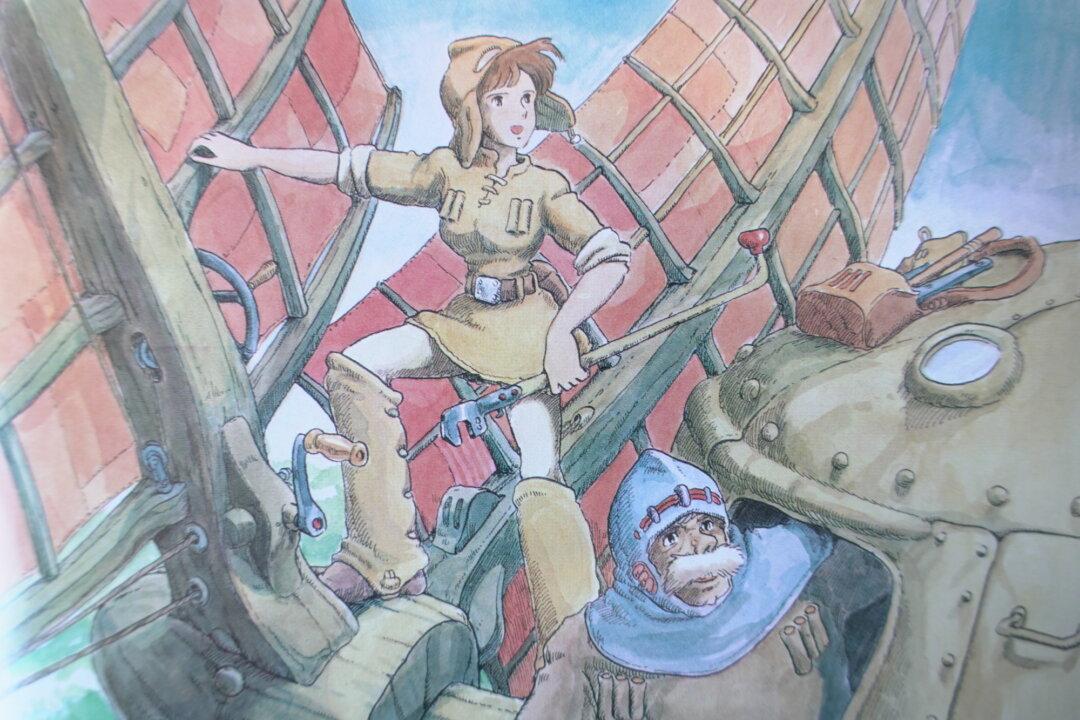An early masterpiece by a legendary storyteller, “Nausicaä of the Valley of the Wind” is a thought-provoking tale worth reading by any young adult, art enthusiast, or manga fan.
The Japanese manga series, written by filmmaker Hayao Miyazaki, co-founder of animation company Studio Ghibli, is considered by many to be his greatest work. The series was published from 1982 to 1994, selling 10 million copies in Japan alone and spawning a 1984 movie of the same name. It was awarded the 1994 Japan Cartoonists Association Award Grand Prize.
The story follows the compassionate and idealistic princess Nausicaä. She lives in a world where most of the Earth has been covered by a huge poisonous forest that crawls with giant insects. Rival empires battle for precious resources, scarce land, and populations. The use of ancient technology, from a time before the forests of lung-rotting miasma, threatens to wipe out the last of humanity.
Nausicaä has the power to talk to the great insects of the forest and telepathically communicate with humans. Her journey from the small kingdom of the Valley of the Wind into the bleak world, where humans fight each other and nature to keep afloat, is one plagued by tragedy, struggle, and loss.
The Godfather of Animation
Miyazaki has been called the “godfather of animation in Japan” by the BBC. The influential director, writer, and animator was born in 1941 in Tokyo. Growing up in post-war Japan, seeing destroyed cities, influenced him towards anti-war and pacifist worldviews that are present in many of his creations.Miyazaki’s most notable works include the animated movies “Princess Mononoke,” “My Neighbor Totoro,” and “Spirited Away.”
His stories have garnered many awards and acclamations, including several Annie Awards, Japan Academy Film Prizes, and a spot on Time magazine’s list of the 100 most influential people in 2005 and 2024. He was named a “Person of Cultural Merit” by the Japanese government in 2012.
A Strong Female Character
The world of Nausicaä is diesel punk. Much of the technology in the story resembles that used during the World War II era, which adds a connection to our time. Even though our era is long gone, old influences remain.Nausicaä is a strong female character—not a painfully dull male character in a female body, the plague of modern storytelling, but a true character.
Her physical abilities are greater than those of most men, but that is not the focus. Her real power is her ability to move people, to love everyone, and to continue on her path. She’s not perfect either. Her selfishness, wrath, and eventual hopelessness must all be overcome.
Her name comes from Homer’s Odyssey, in which a princess named Nausicaä helped a shipwrecked Odysseus.
Miyazaki also took inspiration from a 12th-century Japanese story called “The Lady Who Loved Insects,” about a young court lady who preferred talking to insects over conforming to the court standards of a lady.
An earlier work, a watercolor graphic novel called “Shuna’s Journey,” was prototypical of Nausicaä’s character design.
Miyazaki’s Themes
The series is heavily anti-war, in line with Miyazaki’s pacifist ideals. He nails home the futility and evil of nations destroying themselves to destroy others.Miyazaki’s pacifist themes are certainly not original ideas or subjects—and it may feel like an insult to compare a manga to “All Quiet on the Western Front.” However, his works capture much the same sentiment, in a less dreary manner.
Environmentalism and the dangers of technology are also strongly present in all aspects of the story.
Many of the disasters that occur happen simply because man could not resist tampering with science, abusing the environment, and pursuing technology for unethical reasons. Miyazaki strongly believes in the harmony of man and nature. He preaches that man should not exert control over the natural world, as it leads to disaster.
Later parts of the story deal heavily with overcoming fatalistic nihilism. Reading Nausicaä’s struggle with her literal demon of nihilism may lead those who struggle with meaning to move in a better direction.
And for readers who don’t struggle with this, the work still leaves much to ponder.
The 1984 movie based on Miyazaki’s manga work is worth watching. However, it is not a substitute. Written two years into the manga’s 12-year run, it scrambles the early events of the story into a finished product. It’s amazing in its own right, but not comparable to the source material in terms of quality and depth.
The books are printed in Japanese style, meant to be read backward. The front of the book is where the back of a normal English book would be, and the pages are read right to left. Readers should not be intimidated, however, as this format is not as difficult to navigate as it may initially sound.
“Nausicaä of the Valley of the Wind” is an amazing read. Thoughtful readers who enjoy epic stories should not miss it.








